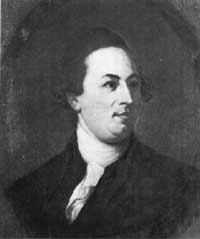







Biographical Sketches
|
WILLIAM PACA Maryland |
 William Paca | |
| ||
The second son of a prominent planter-landowner, Paca was born, probably of Italian descent, in 1740 at Chilbury Hall, near Abingdon in Harford County, Md. He received his early education from private tutors and at the age of 15 matriculated at the College of Philadelphia (later part of the University of Pennsylvania). Upon graduating, he studied with an attorney in Annapolis and read law in London. In 1763, the year before initiating his practice in the former city, he married a local girl from a wealthy family and began building a home, completed 2 years later. When in the country, he resided at Wye Plantation, in Queen Annes County, which he had purchased about 1760.
In 1768 Paca won a seat in the colonial legislature, where he soon alined himself with Samuel Chase and other Whigs in protesting the powers of the Proprietary Governor. In the early 1770's Paca joined other Maryland patriots in urging governmental regulation of fees paid to civil officers and in opposing the poll tax, used to pay the salaries of Anglican clergy, representing the established church. In 1773 he became a member of the Maryland committee of correspondence. The following year, along with Samuel Chase and Thomas Johnson, he acted as counsel for fellow legislator Joseph H. Harrison, who had been jailed for refusing to pay the poll tax. All three men also attended the first provincial convention that same year and received appointments to the First Continental Congress. About this time, Paca's wife died.
Although he sat in Congress until 1779, Paca's most noteworthy efforts were on the State level. In the spring and early summer of 1776, the provincial convention, a relatively conservative body, refused to authorize its congressional Delegates to vote for independence. Paca, aiding Chase and Carroll, drummed up enough support on the home front to persuade the convention to change its mind and bring Maryland into the affirmative column in the congressional voting on July 1-2, 1776. A few months later, he helped draft a State constitution. The next year, he began a 2-year term in the Maryland senate and saw militia duty. In addition, he sat on the council of safety and spent large amounts of his own money outfitting troops.
Between the years 1778 and 1782, Paca distinguished himself first as chief justice of the State Superior Court and then as chief judge of the circuit court of appeals in admiralty and prize cases. During that time, in 1780, a few months after the demise of his second wife, whom he had married 3 years earlier, he sold his home in Annapolis and moved permanently to Wye Plantation. In 1782 he raised funds for Washington College, founded that same year in Chestertown as the first institution of higher learning in Maryland, and served on its board of visitors. As Governor of Maryland (1782-85), he concerned himself with the welfare of war veterans and other postwar problems.
A delegate to the State convention to ratify the Federal Constitution in 1788, Paca urged its adoption if amended and helped draw up a list of proposed amendments. In 1789 President Washington appointed him as Federal district judge. He held this position until 1799, the year of his death at the age of 58, at Wye Hall, on Wye Island across the narrows from his own home, Wye Plantation. The former was the home of his son John, probably the only one of his five children from his two or possibly three marriages who reached maturity. At first interred at Wye Hall, Paca's remains now rest in the family burial ground near Wye Plantation.
Drawing: Oil, date unknown, by Francis B. Mayer, after Charles Willson Peale, Independence National Historical Park.
 |
 |
http://www.cr.nps.gov/history/online_books/declaration/bio36.htm
Last Updated: 04-Jul-2004